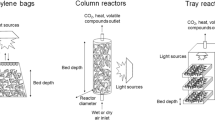Abstract
Microcycle conidiation is a survival mechanism of fungi encountering unfavorable conditions. In this phenomenon, asexual spores germinate secondary spores directly without formation of mycelium. As Penicillium camemberti conidia have the ability to produce conidiophores after germination in liquid culture induced by a thermal stress (18 and 30 °C), our work has aimed at producing conidia through this mean. Incubation at 18 and 30 °C increased the swelling of conidia and their proportion thereby producing conidiophores. Our results showed that the microcycle of conidiation can produce 5 × 108 conidia ml−1 after 7 days at 18 °C of culture. The activity of these conidia was checked through culture on a solid medium. Conidia produced by microcycle conidiation formed a normal mycelium on the surface of solid media and 25 % could still germinate after 5 months of storage.


Similar content being viewed by others
References
Ahearn DG, Price D, Simmons RB, Mayo A, Zhang ST, Crow SA (2007) Microcycle conidiation and medusa head conidiophores of aspergilli on indoor construction materials and air filters from hospitals. Mycologia 99(1):1–6
Alves SB, Rossi LS, Lopes RB, Tamai MA, Pereira RM (2002) Beauveria bassiana yeast phase on agar medium and its pathogenicity against Diatraea saccharalis (Lepidoptera: crambidae) and Tetranychus urticae (Acari: Tetranychidae). J Invertebr Pathol 81(2):70–77
Anderson JG, Smith JE (1971) The production of conidiophores and conidia by newly germinated conidia of Aspergillus niger (Microcycle conidiation). J Gen Microbiol 69:185–197
Anderson JG, Smith JE (1972) The effect of elevated temperatures on spore swelling and germination of Aspergillus niger. Can J Microbiol 18(3):289–297
Bosch A, Yantorno O (1999) Microcycle conidiation in the entomopathogenic fungus Beauveria bassiana bals. (vuill). Proc Biochem 34(6):707–716
Boualem K, Waché Y, Garmyn D, Karbowiak T, Durand A, Gervais P, Cavin JF (2008) Cloning and expression of genes involved in conidiation and surface properties of Penicillium camemberti grown in liquid and solid cultures. Res Microbiol 159:110–117
Dijksterhuis J, Samson RA (2002) Food and crop spoilage on storage. Mycota 11:39–52
Griffin DH (1994) Spore dormancy and germination. Fungal physiology, 2nd edn. Wiley-Liss, New York, pp 375–398
Hanlin RT (1994) Microcycle conidiation a review. Mycoscience 35:113–123
Jing L, Yueqing C, Yuxian X (2010) Mmc, a gene involved in microcycle conidiation of the entomopathogenic fungus Metarhizium anisopliae. J Invertebr Pathol 105:132–138
Kolmark HG (1984) Mutants with continuous microcycle conidiation in the filamentous fungus Fusarium solani f. sp. pisi. Mol Gen Genet 198:12–18
Krasniewski I, Molimard P, Feron G, Vergoignan C, Durand A, Cavin JF, Cotton P (2006) Impact of solid medium composition on the conidiation in Penicillium camemberti. Proc Biochem 41:1318–1324
Lapaire CL, Dunkle LD (2003) Microcycle conidiation in Cercospora zeae-maydis. Phytopathology 93(2):193–199
Latgé JP, Bouziane H, Diaquin M (1998) Ultrastructure and composition of the conidial wall of Cladosporium cladosporioides. Can J Microbiol 34:1325–1329
Maheshwari R (1991) Microcycle conidiation and its genetic basis in Neurospora crassa. J Gen Microbiol 137:2103–2115
Mangenot F, Reisinger O (1976) Form and function of conidia as related to their development. In: Weber DJ, Hess WH (eds) The fungal spore. Form and function. Wiley, New York, pp 789–847
Morton AG (1961) The induction of sporulation in mould fungi. Proc R Microsc Soc B 153:548–569
Morton AG, England DJF, Towler DA (1958) The physiology of sporulation in Penicillium griseofulvum Dierckx. Trans Brit Soc 1:39–51
Park D, Robinson PM (1970) Germination studies with Geotrichum candidum. Trans Br Mycol Soc 54:83–92
Pascual P, Melgarejo S, Magan N (1997) Induction of submerged conidiation of the biocontrol agent Penicillium oxalicum. Appl Microbiol Biotechnol 48(3):389–392
Pascual S, De Call A, Magan N, Melgarejo P (2000) Surface hydrophobicity, viability and efficacy in biological control of Penicillium oxalicum spores produced in aerial and submerged culture. J Appl Microbiol 89:847–853
Roncal T, Ugalde U (2003) Conidiation induction in Penicillium. Res Microbiol 154(8):539–546
Sekiguchi J, Gaucher GM, Costerton JW (1975) Microcycle conidiation in Penicillium urticae: an ultrastructural investigation of spherical spore growth. Can J Microbiol 21:2048–2058
Shizhu Z, Guoxiong P, Yuxian X (2010) Microcycle conidiation and the conidial properties in the entomopathogenic fungus Metarhizium acridum on agar medium. Biocontrol Sci Technol 20(8):809–819
Smith JE (1978) Asexual sporulation in filamentous fungi. In: Smith JE, Berry DR (eds) The filamentous fungi, 3. Wiley, New York, pp 214–239
Smith JE, Anderson JG, Deans SG, Berry DR (1981) Biochemistry of microcycle conidiation. In: Cole GT, Kendick B (eds) Biology of conidial fungi, vol 2. Academic Press Inc, New York, pp 329–356
Tronchin G, Esnault K, Renier G, Filmon R, Chabasse D, Bouchara JP (1997) Expression and identification of laminin binding protein in Aspergillus fumigatus conidia. Infect Immun 65(1):9–15
Úrbez-Torres JR, Bruez E, Hurtado J, Gubler WD (2010) Effect of temperature on conidial germination of Botryosphaeriaceae species infecting grapevines. Plant Dis 94(12):1476–1484
Wessels JGH (1997) Hydrophobins: proteins that change the nature of the fungal surface. Adv Microb Physiol 38(38):1–45
Acknowledgments
K. Boualem was supported by a PhD Franco-Algerian grant and by the CROUS of Dijon. This study was supported by the French Minister of Education and Research, the Conseil Régional de Bourgogne, and INRA. We are very grateful to Christine Rojas and Bernadette Rollin for laboratory work.
Author information
Authors and Affiliations
Corresponding authors
Rights and permissions
About this article
Cite this article
Boualem, K., Gervais, P., Cavin, JF. et al. Production of conidia of Penicillium camemberti in liquid medium through microcycles of conidiation. Biotechnol Lett 36, 2239–2243 (2014). https://doi.org/10.1007/s10529-014-1596-0
Received:
Accepted:
Published:
Issue Date:
DOI: https://doi.org/10.1007/s10529-014-1596-0




